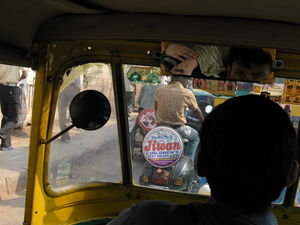Advertisement
Published: October 28th 2007

 Tuk Tuk Parade
Tuk Tuk Parade
An autorickshaw ride in Delhi.“It begins with the streets…”
- Samir, a Delhi-born New Yorker prepares to explain what he hates the most about living in India
Traffic, “like you say in America,” is a bitch. In India, that’s something of an understatement. The streets here might well be at least partially responsible for the continuing growth of religion. The baseline for everyday danger is so high that one must cook up a mantra, a prayer to the gods, to maintain calm and poise amidst the chaos. I’ve taken to drumming my fingers, nodding my head, and humming Barrington Levy: “I’m broad… I’m broad… I’m broader than broadway!” It helps.
After a few rides in dinged-up autorickshaws, one starts to talk like a grizzled war veteran. “The things I’ve seen…”
(1) About 18,000 near misses. The margins for Delhi drivers are measured in millimetres. The majority of drivers fold back their mirrors to get those few extra inches clearance when passing in traffic. These near misses are made vaguely more dismaying by the dents, dings, and scratches one sees along the sides of nearly every passing vehicle.
(2) A distinct absence of turn-signals and brake lights. In their place, Indians have a catch-all signal in their road arsenal--the horn. Horns come in a wide variety of tones here, from the simple toot to the Doppler effect blare to the angry fart. All are utilized in abundance. The formerly one-dimensional honk seems able to communicate a multitude of different messages: “I’m passing.” “I’m stopping.” “I’m turning.” “I’m merging.” “I’m preparing to swerve into oncoming traffic.” “Get off the sidewalk, I’m driving here.” “That foreign woman has an ample bosom.” “I dislike you.” “May the monkeys take you!” “Go to either the icy or hot Hindu hell!!” And so on.
(3) Desperate rickshaw touts attempting to literally talk you out of a moving vehicle and into their own. “Rickshaw!” ranks about second on the list of things that were shouted at us in Varanasi, coming after “Boat!” (or “Romantic boat!”), but before “Silk,” “Massage,” and “Shave!” (As you might’ve surmised from the pictures, I’m toying with the idea of seeing how long a travel stache my Asian genes will allow me to grow. With luck, I’ll be a respectable entrant in the annual moustache competition by the time we arrive in Pushkar.) Most recently, on our way to the Varanasi train station, a man jumped into the cab of our moving autorickshaw and rode the remaining distance to the station halfway on our driver’s lap.
(4) Drivers accelerating directly towards scared-shitless tourists/Indian commuters staggering under the weight of the knock-off Gucci suitcases and Nike ruck-sacks that they’re carrying on their heads/street vendors/groups of small children/oncoming traffic while leaning on their horns. Many areas in India lack the clear distinction between sidewalk and street that Westerners tend to take for granted. They usually lack sidewalks as well. In their stead is a churning morass of people, animals, and traffic with a clear hierarchy. From lowest to highest: dogs, pedestrians, rickshaws, autorickshaws, small cars, taxis, jeeps, trucks, big trucks, and cows. Cows get a free pass because of their sacred status in Hindu culture, but everything else on the list must get the hell out of the way of everything higher up on the food chain of the Indian street.
All of these sights are augmented by the fact that my daily peek at the Hindustan Times always, ALWAYS contains a traffic death story (Ex. “Blue-line Bus Driver Finally Shows Heart, Admits Killing Motorcyclist”) Because, hell, without a good traffic fatality it just wouldn’t be… Thursday.
Advertisement
Tot: 0.098s; Tpl: 0.032s; cc: 7; qc: 44; dbt: 0.0443s; 1; m:domysql w:travelblog (10.17.0.13); sld: 1;
; mem: 1.1mb

 Tuk Tuk Parade
Tuk Tuk Parade